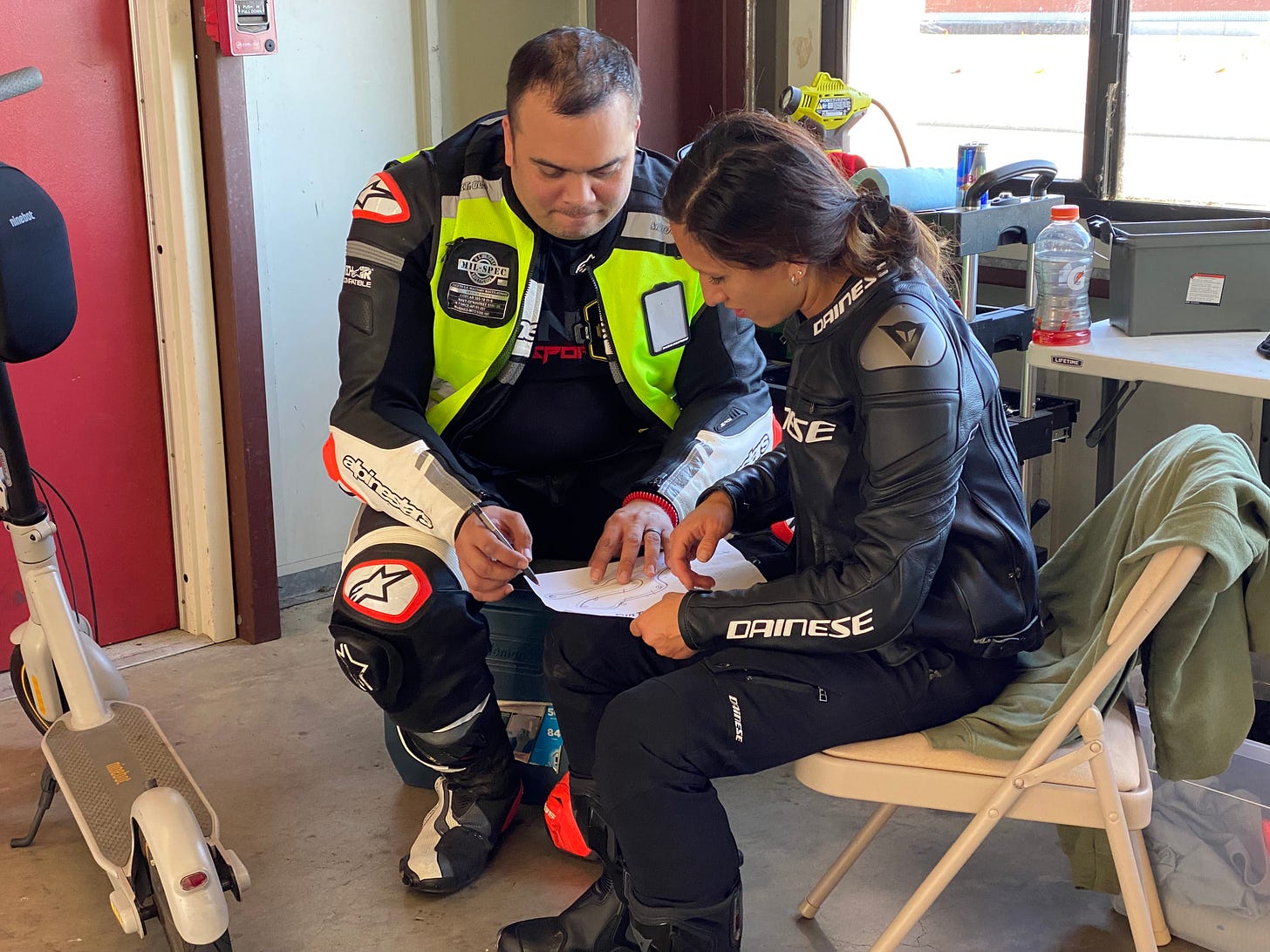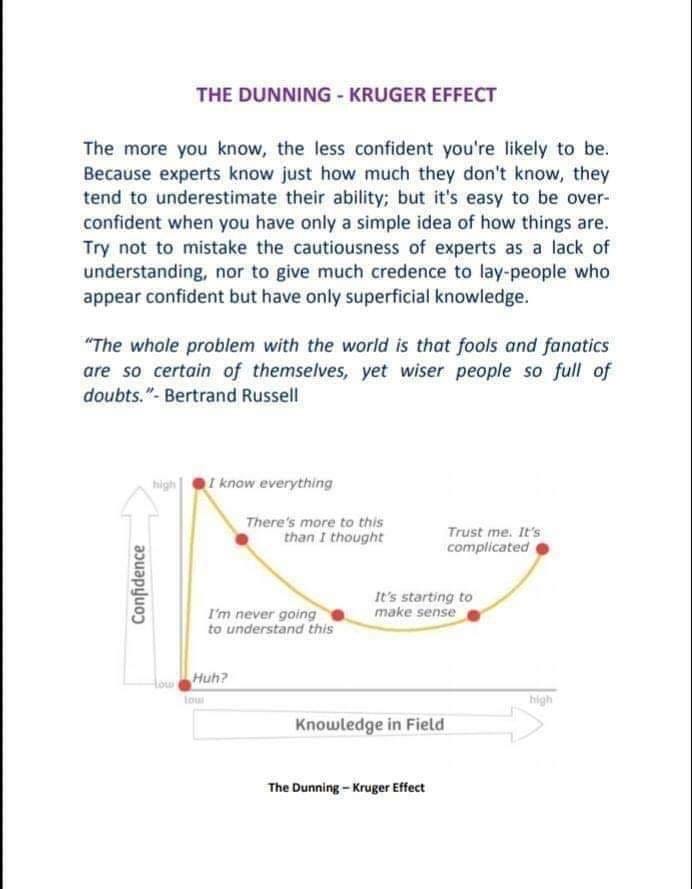Ego
We all take a lot of pride in this chosen hobby/sport, it might be part of your identity. When we first get into it, most of us think we're pretty good, pretty quick around a twisty road. Maybe that's true, but the first time on a racetrack can be one of the most humbling experiences we ever have. Maybe for your first track day, you sign up for the intermediate group. Nearly everyone who does is very quickly schooled that they might not be as quick as they thought they were and after a couple of sessions, you move to C or novice group and just try to get through the day. I've been there myself. You look around the paddocks and you see bikes with race numbers, trick bits, custom leathers, well-worn knee sliders, crashed bikes heading back out on track with makeshift repairs and you might start thinking you're in a little over your head.
If you've chosen to stick with this whole track thing and get a few days under your belt and you're starting to find your way around the track, but you haven't worked with a school/coach/control rider, you might assume the way to get better is to just try harder (i.e., later brakes, more throttle, more lean angle, etc.). It's around this point where you're probably starting to put yourself and others at risk. You're likely finding that you have more pucker moments, a few off-track excursions, etc. If this sounds familiar and is your present situation, you're past due to check your ego and work with someone. This is hard to do, I know. Maybe you're on the faster end of your riding group, maybe others are looking to you for lap times and passes. Just because you can get around the track quickly doesn't mean that you're doing it *right*. I look back at some of my videos from 2018 and while I was on the faster end of the B group, I'm pretty fortunate I didn't crash or cause someone else to crash, a lot of times I was using the wrong control at a given time, my lines weren't smooth and consistent, my passes were too aggressive; frankly, it's embarrassing.
Flashback to late 2018-early 2019, I was wanting to get the lap times, I started looking into coaching. I had previously attended California Superbike School and Reg & Jason Pridmore's separate schools (mostly pre-marriage and kids). Upon reflection, I honestly hadn't paid the type of attention I should have to those schools. Because I wasn't doing it regularly or with enough focus, I was more of a tourist. Late 2018, I signed up for an online riding academy that would offer periodic video reviews of riding, I started learning how to use the AiM software and review data. In 2019, I signed up for the Rickdiculous school. It was about this time that I started listening to the Ken Hill Podcast. Much of it was over my head, but I re-listened to every episode probably 3 or 4 times that year alone (and still do multiple times each year). In 2020 I hired one of Ken's coaches for private coaching. My progress was slow but I eventually started to quit letting my ego and pride run the show. The more I let myself be open to criticism, quit making excuses, and truly worked with my riding coaches, the more progress I made.
It's difficult to put the pride away and check the ego, but when you really do, you'll find that you're able to make proper progress. One very important part of this process is working with a consistent pedagogy. I have one instructional coach and his methodology works for me. It's a cerebral way of thinking about my riding and technique, with the underlying theme of faster/safer. In my own mind, I extend that to thinking about the physics of how everything works. I do still draw from my experiences with CSS, ChampSchool, and a racer/control rider I worked with during 2019--I found value in everything. If the instruction is done right, the objectives are largely the same but the way some coaching works, it might resonate better for you. As far as pace, I'm comfortably into A group and though I'm considerably quicker around the track, I can't recall the last time I had a pucker moment. I track my heart rate and most of the time it peaks around 120bpm, occasionally 140bpm. I pride my accuracy more than I do lap times but yet the lap times are improving. I've truly opened myself up for coaching and review, I love this sport and I want to continue to improve. The beauty is that all of the things I learn for better track riding applies to street riding and even driving my car (the degree of application is reduced dramatically, of course). The way that I focus on this track thing has translated into my personal life and work-life, I'm more efficient, more deliberate, and it's honestly improved the quality of my life.
Here's another fundamental thing: I used to be afraid of admitting to something being scary to do. Motorcycles are kind of a tough guy thing, you're not supposed to be scared doing a manly thing, right? Now, I'm fine with admitting it--age, humility, and passion have a way of changing you. Holding the throttle wide open (truly doing it, not what you might *think* you're doing) to what you know is a safe braking marker is scary. I've had throttle data for a few years now and working up to executing has been a long and slow process. I'm far from perfect on it yet but I'm making progress. Thunderhill East is a fast track, it has three areas where I'm ~120mph+ with a supersport bike (4 if I weren't scared of going that fast through T7 on the way to T8). I know I can go wide open on the N4 through T8, but I don't, because it's scary and I'm not used to turning while on the throttle. I don't know that I'll ever be able to go wide open over T1 at Laguna with a supersport. It's okay to admit that something scares you. If you're working with a coach, this will help them work with you on scary parts. When you admit to something being spooky to you amongst your riding peers, they will likely open up and offer suggestions.
The first time I did a video review, it was with California Superbike School and they have this tripod with a camera on top with the whole assembly attached to the rear of one of their fleet bikes and it gives a pretty good forward high up vantage and you can see what the rider is doing at the same time. ChampSchool (YCRS) will have a session where they send an instructor out on chase for a lap and then later, with everyone in the classroom, they critique your riding. Ken and his coaches will run video on you as well but it's usually reviewed privately. While it can be intimidating and humbling, video review is a tremendous teaching tool and my favorite first stage of coaching. Video review will demonstrate your ability to achieve direction (lines/placement), control timing (using the right control at the right time), and body position/timing. Even now, a few years into this, I'll periodically ask a control rider at a track day to run video on me. Most of the control riders have GoPro mounts attached to their bikes so I just come over with my charged camera, lots of space on the card, and ask them to run chase on their lines. Their lines may not be the same as mine but that's fine. I have a pretty good idea of what I'm looking for at this point. Because my methodology might be different than theirs and I don't want to muddy the waters, I usually don't ask them for critique unless they see something obvious. The last time I did this my riding coach picked up a bunch of things, including some things that, if I were to add much more speed to them, could have bad consequences. I was able to sort out most of it for the next track day by practicing with the bike on stands in the garage, it just required me to be conscious of them. Specifically, one was smoothing my left-right body transitions and the other was turning in earlier and slower. Recently I asked a control rider to run chase on me on the N4 and out of the blue he said, "I know you're hanging off, but I can't see when you move from side to side." Because my coach was earlier able to pick that up from the video, I was able to execute on it and smooth my transitions and inputs.
The moral of the story is that if you truly want to embrace the faster/safer concept, accept that you can improve, start with a riding school and as things improve, work with a riding coach who resonates with you. Admit your fears, give them some insight into how you process data and feedback and work with them. Do take pride in your development but don't dwell on it too long, make sure you're doing the right thing at the right time, and work to refine that. You don't have to compare yourself to others, the best measure is to compare the ever-changing new you to the old you.
If you're interested in remote video review, Ken Hill and other coaches are available via the Blayze.io platform. I receive no compensation for this, my interest is in sharing what has helped me improve and wanting to keep more people riding safely.
https://www.youtube.com/watch?v=kalgy93ANNU




